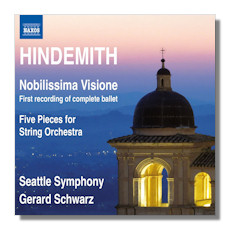
The Internet's Premier Classical Music Source
Related Links
- Hindemith Reviews
- Latest Reviews
- More Reviews
-
By Composer
-
Collections
DVD & Blu-ray
Books
Concert Reviews
Articles/Interviews
Software
Audio
Search Amazon
Recommended Links
Site News
 CD Review
CD Review
Paul Hindemith

- Nobilissima Visione *
- Einleitung und Lied des Troubadour
- Tuchkaufer und Bettler
- Der Ritter
- Marsch
- Erscheinung der drei Frauen
- Festmusik
- Schluss des Festes
- Meditation
- Geigenspiel/Der Wolf
- Kargliche Hochzeit
- Incipiunt laudes creaturarum
- 5 Pieces for String Orchestra, Op. 44 #4 **
- Langsam
- Langsam
- Lebhaft
- Sehr langsam
- Lebhaft
* Ko-ichiro Yamamoto, trombone
** Emma McGrath, violin
Seattle Symphony Orchestra/Gerard Schwarz
Naxos 8.572763 59m
Naxos claims this is the first complete recording of Hindemith's ballet Nobilissima Visione (1937-1938), but it is not: Karl Anton Rickenbacher and the Bamberg Symphony Orchestra recorded it for Koch-Schwann, which issued the performance in 1995. So, this is probably just the second recording of the complete ballet. The three movement suite Hindemith drew from the work, however, has achieved a substantial level of popularity. Still, what accounts for the neglect of the full ballet score? As I wrote in my review of several Hindemith chamber sonatas in 2013 (Blue Griffin BGR277), the composer's reputation has declined noticeably in the last several decades. In a sense it's easy to see why: Hindemith didn't reinvent himself or strike out new paths with the success of Stravinsky; nor did he generally write the catchy melodies or imaginatively audacious kind of music associated with Prokofiev; and neither did he employ angst and tragedy with the dynamism of Shostakovich. In short, Hindemith's music rarely draws attention to itself. Alongside the works of the three composers mentioned above, Hindemith's music will likely sound less colorful and rather modest to the average listener. But his style is just as individual, and his best music can stand with the finest works of the 20th century, even if he never wrote a mega-hit like The Rite of Spring, Petrouchka, the Classical Symphony or Romeo and Juliet. Perhaps his star will rise again, but I won't hold my breath because there's a spate of talented contemporary composers struggling for whatever elbow room is left in the repertory.
This fine disc may help Hindemith's cause. The ballet's sound world shares much in common with Hindemith's opera Mathis der Maler and the Mathis der Maler Symphony. Nobilissima Visione's scoring is often modest and transparent and features much writing for winds, in particular for the trombone. Consisting of six scenes and eleven dance numbers, the music divulges a mixture of moods, though is largely optimistic and heroic. True, there are numbers such as Appearance of the Three Women (#5) and Meditation (#8) that are somewhat somber or even austere. But even here the music avoids a sense of gloom, and for the most part imparts an air of religiosity. The ballet's main theme, which is heard in the first number, Introduction and Song of the Troubadour, and reappears throughout the work, is a version of the tune used in a 13th century song: It was in May. Hindemith's writing is subtle throughout the ballet and it's difficult to pick highlights, though one could mention the final number, The Songs of Praise of the Creatures Begins, as perhaps the crowning jewel of the work as it builds gloriously to final triumph. The performance under the masterly baton of Gerard Schwarz is convincing and totally committed.
The Five Pieces for String Orchestra, Op. 44, #4, dates to 1927 and is a rather modest collection of pieces originally meant to have educational value for student performers. Well, over the years Five Pieces has garnered attention from both student and professional ensembles, not least because there is little about the music that sounds pedagogical or academic. That said, much of it is somber and quite serious, though the scoring is very transparent and the expressive language accessible. The five movements are short, the whole work lasting under fifteen minutes. In the end, it makes a splendid filler for this disc, especially as the performance is once again excellent. The sound reproduction in both works is powerful and clear. Highly recommended!
Copyright © 2014, Robert Cummings




















